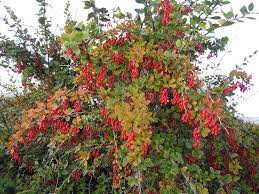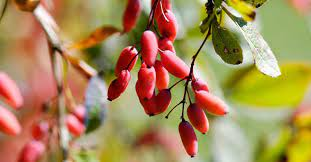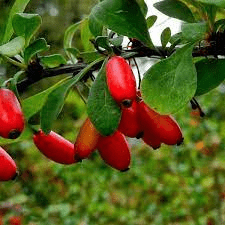Berberis vulgaris, commonly known as Barberry, is a deciduous shrub belonging to the Berberidaceae family. Native to Europe, North Africa, and Western Asia, this shrub has been cultivated and naturalized in various regions across the world.
Barberry is valued for its ornamental qualities, as well as for its historical uses in traditional medicine and culinary applications.
Morphologically, Barberry typically grows to a height of 1 to 3 meters, with thorny branches and small oval-shaped leaves. The shrub produces bright yellow flowers in late spring, which give way to red or dark purple berries in the fall.
These berries are characterized by a distinctive tart flavor and are used in the preparation of jams, jellies, and certain culinary dishes.
Barberry has a long history of medicinal use in traditional systems such as Ayurveda and traditional Chinese medicine. The plant contains several bioactive compounds, including berberine, which is recognized for its antimicrobial, anti-inflammatory, and antioxidant properties.
Berberine has been studied for its potential therapeutic effects on various health conditions, including infections, gastrointestinal issues, and cardiovascular health.
In traditional medicine, Barberry has been employed to treat ailments such as digestive disorders and skin conditions. The antimicrobial properties of berberine make it effective against certain bacteria and fungi. Additionally, the plant’s root bark has been historically used for its bitter taste, which is believed to stimulate digestive functions.
Culturally, Barberry has also found its place in landscaping and ornamental gardens due to its vibrant berries and adaptable nature. However, it is important to note that some regions have classified certain species of Barberry as invasive, as they can spread and outcompete native vegetation.
As with any medicinal plant, it is crucial to exercise caution and consult with healthcare professionals before using Barberry or its derivatives for therapeutic purposes, as improper use may lead to adverse effects.
Despite its historical significance and cultural uses, ongoing research continues to explore the full range of potential health benefits and risks associated with Barberry.
The Botanical Description of Barberry
1. Deciduous Shrub: Barberry refers to a deciduous shrub, characterized by seasonal leaf shedding and renewal.
2. Thorny Branches: The plant is known for its thorny branches, contributing to its distinct appearance.
3. Alternate Leaves: Barberry exhibits alternate leaves along its branches, arranged in a staggered pattern.
4. Yellow Flowers: During the blooming season, barberry produces small, yellow flowers that add to its ornamental value.
5. Berries: Following flowering, the plant develops berries, often red or blue, depending on the species.
6. Colorful Foliage: Some varieties of barberry boast vibrant foliage, with shades of red, purple, or gold, enhancing landscaping aesthetics.
7. Varied Sizes: Barberry comes in various sizes, ranging from compact varieties suitable for borders to larger landscape options.
8. Adaptive to Soil Types: The shrub is adaptable to different soil types, including well-drained loam and clay.
9. Hardy and Drought-Tolerant: Barberry is known for its hardiness and ability to withstand drought conditions once established.
The Geographic Distribution of Barberry
1. Native Regions: Barberry is native to regions of Europe, Asia, and Africa.
2. Naturalized in North America: Over time, barberry has become naturalized in parts of North America.
3. Thrives in Temperate Climates: The plant thrives in temperate climates, adapting well to a variety of environmental conditions.
4. Common in Landscapes: Barberry is commonly used in landscaping and gardening, appreciated for its ornamental features.
5. Invasive Concerns: Some regions experience issues with certain barberry species becoming invasive, impacting local ecosystems.
6. Cultivation in Gardens: Barberry is often cultivated in gardens and parks for its aesthetic appeal and adaptability.
7. Resilient Growth: The shrub exhibits resilient growth and can tolerate a range of soil types, from acidic to alkaline.
8. Susceptibility to Pests: While hardy, barberry can be susceptible to certain pests, including aphids and rust diseases.
The Chemical Composition of Barberry
1. Berberine: Barberry contains berberine, a compound with antimicrobial and anti-inflammatory properties.
2. Alkaloids: Various alkaloids, aside from berberine, contribute to the plant’s medicinal qualities.
3. Flavonoids: Barberry is a source of flavonoids, known for their antioxidant effects.
4. Tannins: Tannins, with astringent properties, are present in barberry.
5. Resins: Resins found in barberry may contribute to its therapeutic effects.
6. Essential Oils: Some varieties of barberry produce essential oils, adding to the plant’s chemical diversity.
7. Antioxidants: The presence of antioxidants in barberry supports its potential health benefits.
8. Vitamin C: Barberry may contain vitamin C, enhancing its nutritional profile.
9. Quercetin: The flavonoid quercetin, known for anti-inflammatory effects, is found in barberry.
10. Beta-Carotene: Barberry may contain beta-carotene, a precursor to vitamin A.
11. Vitamin B Complex: Certain B vitamins are present in barberry, contributing to its nutritional value.
12. Minerals: Barberry contains minerals like iron and zinc, adding to its nutritive content.
Read Also: 19 Medicinal Health Benefits Of Damiana (Turnera diffusa)
The Medicinal Health Benefits Of Barberry (Berberis vulgaris)

1. Anti-Inflammatory Effects: Berberine in barberry exhibits anti-inflammatory properties, potentially beneficial for inflammatory conditions.
2. Antimicrobial Properties: Barberry’s compounds, including berberine, have antimicrobial effects against bacteria, viruses, and fungi.
3. Digestive Health: Barberry may support digestive health by promoting healthy gut flora and alleviating gastrointestinal issues.
4. Cardiovascular Support: Berberine has been studied for its potential to support cardiovascular health by lowering cholesterol and improving blood vessel function.
5. Immune System Boost: The antimicrobial and antioxidant properties of barberry may contribute to immune system support.
6. Blood Sugar Regulation: Berberine’s effects on insulin sensitivity may aid in regulating blood sugar levels.
7. Liver Health: Barberry has been traditionally used to support liver function and promote detoxification.
8. Skin Conditions: External applications of barberry may help with certain skin conditions, thanks to its antimicrobial effects.
9. Respiratory Health: Barberry may offer relief for respiratory conditions, including coughs and bronchitis.
10. Anti-Cancer Properties: Some studies suggest that berberine in barberry may have anti-cancer properties, inhibiting the growth of certain cancer cells.
11. Antioxidant Support: The flavonoids and other antioxidants in barberry contribute to overall cellular health by neutralizing free radicals.
12. Urinary Tract Health: Barberry’s diure
tic properties may support urinary tract health.
13. Joint Discomfort: Barberry’s anti-inflammatory effects may provide relief for joint discomfort.
14. Eye Health: Antioxidants like beta-carotene and vitamin C in barberry contribute to eye health.
15. Allergy Relief: Barberry’s anti-inflammatory effects may offer relief for certain allergic conditions.
16. Weight Management: Berberine’s influence on metabolism may contribute to weight management.
17. Cognitive Function: Some studies suggest that barberry may have cognitive benefits, potentially supporting brain health.
18. Antifungal Effects: Barberry’s compounds, including berberine, may exhibit antifungal effects.
19. Menstrual Health: Traditional uses include barberry for supporting menstrual health.
The Methods of Usage to Achieve the Provided Health Benefits Of Barberry (Berberis vulgaris)
1. Herbal Teas: Prepare barberry herbal teas using dried leaves or berries for digestive and immune support.
2. Tinctures: Tinctures of barberry can be taken for a concentrated dose of its medicinal compounds.
3. Capsules or Tablets: Barberry supplements, available in capsule or tablet form, offer a convenient way to incorporate its benefits.
4. External Applications: Infuse oils with barberry for topical applications, such as for skin conditions or joint discomfort.
5. Culinary Uses: Some culinary uses of barberry include incorporating the berries into jams, sauces, or desserts.
6. Decoctions: Prepare decoctions by boiling barberry bark for respiratory or digestive health benefits.
7. Herbal Infusions: Infuse oils or vinegars with barberry for culinary or medicinal applications.
8. Poultices: Create poultices using mashed barberry leaves for external applications on the skin.
9. Culinary Seasoning: Barberry’s tangy flavor makes it a unique addition to various culinary dishes.
10. Inhalation: Inhale the aroma of barberry by steeping its leaves for potential respiratory benefits.
The Side Effects Of Using Barberry Medicinal Plant
1. Pregnancy and Breastfeeding: Pregnant and breastfeeding individuals should avoid barberry due to potential uterine-stimulating effects.
2. Allergic Reactions: Some individuals may experience allergic reactions to barberry, especially if sensitive to plants in the Berberidaceae family.
3. Gastrointestinal Upset: Excessive consumption of barberry may lead to gastrointestinal upset.
4. Blood Pressure: Barberry may lower blood pressure; individuals with low blood pressure should use it cautiously.
5. Medication Interactions: Barberry may interact with certain medications; consult healthcare providers if on medication.
6. Liver Conditions: Individuals with liver conditions should avoid barberry due to its potential impact on liver function.
7. Kidney Conditions: Excessive use of barberry may be harmful to individuals with kidney conditions.
8. Blood Sugar Levels: Barberry’s impact on blood sugar levels may affect individuals with diabetes; monitor levels closely.
9. Photosensitivity: Some individuals may experience photosensitivity when using barberry externally; use caution in the sun.
10. Neurological Effects: Berberine in barberry may cross the blood-brain barrier; use cautiously, especially in sensitive individuals.
11. Surgery: Discontinue barberry use at least two weeks before scheduled surgery due to potential effects on blood pressure and bleeding.
12. Gastrointestinal Disorders: Individuals with conditions like Crohn’s disease or ulcerative colitis should avoid barberry due to potential exacerbation of symptoms.
13. Children and Infants: Barberry is not recommended for use in children or infants due to lack of sufficient safety data.
Read Also: How to Grow, Use and Care for Uruguayan Pampas Grass (Cortaderia selloana)
The Scientific Research and Studies of Barberry (Berberis vulgaris)

1. Antimicrobial Effects: Research has explored the antimicrobial properties of berberine, a key compound in barberry.
2. Anti-Inflammatory Properties: Studies suggest that barberry may exhibit anti-inflammatory effects, potentially beneficial for various health conditions.
3. Cardiovascular Health: Some research indicates that berberine in barberry may contribute to cardiovascular health.
4. Antioxidant Activity: Barberry’s antioxidant activity has been studied for its potential in combating oxidative stress.
5. Blood Sugar Regulation: Studies have investigated berberine’s role in regulating blood sugar levels.
6. Liver Function: Research suggests that barberry may have hepatoprotective effects, supporting liver function.
7. Respiratory Health: Barberry has been traditionally used for respiratory conditions; studies aim to understand its mechanisms.
8. Anti-Cancer Properties: Some studies explore berberine’s potential anti-cancer effects, inhibiting the growth of certain cancer cells.
9. Immune System Modulation: Barberry’s impact on the immune system is an area of interest in scientific research.
10. Cognitive Effects: Preliminary studies suggest that berberine may have cognitive benefits, supporting brain health.
11. Urinary Tract Health: Research has explored barberry’s effects on urinary tract health, including potential antimicrobial action.
The Safety Precautions and Recommendations In Using Barberry (Berberis vulgaris) Medicinal Plant
1. Consultation with Healthcare Professionals: Before incorporating barberry into medicinal routines, consultation with healthcare professionals is advised.
2. Allergic Sensitivities: Individuals with known allergies to plants in the Berberidaceae family should exercise caution and perform patch tests.
3. Dosage Moderation: Use barberry in moderation, especially when considering internal consumption or concentrated forms like supplements.
4. Pregnancy and Nursing: Pregnant and nursing individuals should consult healthcare providers before using barberry for medicinal purposes.
5. Internal Use Caution: While culinary use is common, excessive internal use may lead to adverse effects; moderation is key.
6. Children and Pets: Keep barberry products out of reach of children and pets, especially supplements.
7. Topical Applications: Properly dilute barberry essential oil for topical applications to avoid skin irritation.
8. Sensitivity Testing: Perform sensitivity testing, especially for topical applications, to ensure there are no adverse reactions.
9. Sun Exposure: Individuals using barberry oil externally should be cautious about sun exposure due to potential photosensitivity.
10. Respiratory Use Precautions: Exercise caution when using concentrated barberry oil for respiratory purposes to prevent irritation.
11. Medication Interactions: Individuals on medications should consult healthcare providers due to potential interactions.
12. Asthma and Respiratory Conditions: Those with asthma or respiratory conditions should use barberry with caution due to potential respiratory effects.
FAQs About Barberry (Berberis vulgaris) Medicinal Plant
1. Is Barberry Safe for Culinary Use?
Yes, barberry is commonly used in culinary applications, adding a tangy flavor to various dishes.
2. Can Barberry be Grown at Home?
Yes, barberry can be grown in gardens or containers, providing both ornamental value and potential medicinal uses.
3. What Are the Different Species of Barberry?
There are numerous species of barberry, including Berberis vulgaris, Berberis thunbergii, and Berberis darwinii.
4. How Does Barberry Contribute to Garden Health?
Barberry is known to repel certain pests, contributing to garden health, but its invasive potential should be considered.
5. Can Barberry Berries Be Eaten Fresh?
While the berries are edible, they are often tart, and culinary use typically involves cooking or processing.
6. Can Barberry Be Used for Natural Dyeing?
Yes, barberry has been historically used for natural dyeing, producing shades of yellow to red.
7. What Are Common Culinary Uses of Barberry?
Barberry berries are used in jams, sauces, desserts, and as a tangy seasoning in various dishes.
8. How Long Does it Take for Barberry to Flower?
Barberry typically flowers in late spring to early summer, depending on the species and local climate.
9. Are There Barberry Varieties Without Thorns?
Yes, there are thornless varieties of barberry available, providing a safer option for landscaping.
10. Can Barberry Be Used in Traditional Medicine?
Yes, barberry has a history of use in traditional medicine for various health benefits.
11. Is Barberry Invasive?
Certain species of barberry, such as Berberis thunbergii, can become invasive in certain regions.
12. How Fast Does Barberry Grow?
Barberry is known for its moderate to fast growth, depending on environmental conditions and species.
13. Can Barberry Be Grown Indoors?
Yes, certain compact varieties of barberry can be grown indoors in containers.
14. Does Barberry Attract Wildlife?
Barberry can attract birds with its berries, but its thorny branches may deter some wildlife.
15. What Are Some Landscape Design Ideas With Barberry?
Barberry can be used as hedges, borders, or focal points in landscaping, providing both aesthetic and practical benefits.
16. How to Prune Barberry?
Pruning barberry is typically done in late winter or early spring to maintain shape and size.
17. Can Barberry Be Propagated from Cuttings?
Yes, barberry can be propagated from cuttings, making it a relatively easy plant to propagate.
Read Also: What is Daisy Flower? Benefits, Uses and Importance

